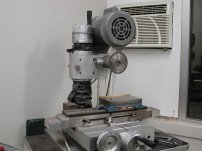Just a Sparky
Hot Rolled
- Joined
- May 2, 2020
- Location
- Minnesota
I'm looking for a solution that will allow me to re-sharpen endmills (teeth and flutes) and drill bits. The ability to handle HSS lathe tools in a square collet would be a nice bonus, but that's not something I can't already manage with my bench grinder on the infrequent basis that I need a special tool. I need something small and semi-portable (i.e. a benchtop machine) as I simply do not have the floor space to capitalize on the myriad full-sized T&C grinders floating around on Marketplace, etc. for cheap.
This is something for personal use, not for profit, so price is a point of concern. At the same time though, I understand that ponying up for something nicer than the bare minimum has benefits. (Obviously)
Right now I'm trying to figure out what all is out there for options that fit my needs and what the pros & cons are of each.
So far I've seen second-hand Cuttermaster units for $1-2k before freight including varying amounts of accessories and attachments, a Deckel 'S0' locally for around $500, and various import Deckel clones that come as complete kits advertised as having endmill sharpening capability hovering around the $700-1,400 range delivered.
- The Cuttermaster units (FCG-30s mostly) are attractive in that they appear to be a rigid, well-built solution that is ready to use with no screwing around. The downsides obviously being the price tag and the weight... both for freight and for having to engine-hoist it onto and off of my workbench + bolster said workbench. (250 lbs.)
- The local Deckel machine looks well-made, but from my limited research, the D0 does not come supplied with much in the way of endmill capabilities. Is that correct?
- And lastly, the import machines are... well, import machines. I don't think I need to go into great detail. The biggest concern I have with those is with complaints about them not forming very good geometry on drill bits. Kind of defeats the purpose of the machine.
Are there other options I haven't listed yet? Thoughts and input on the ones I have? What should I be looking/checking for on used T&C grinders, aside from the obvious?
This is something for personal use, not for profit, so price is a point of concern. At the same time though, I understand that ponying up for something nicer than the bare minimum has benefits. (Obviously)
Right now I'm trying to figure out what all is out there for options that fit my needs and what the pros & cons are of each.
So far I've seen second-hand Cuttermaster units for $1-2k before freight including varying amounts of accessories and attachments, a Deckel 'S0' locally for around $500, and various import Deckel clones that come as complete kits advertised as having endmill sharpening capability hovering around the $700-1,400 range delivered.
- The Cuttermaster units (FCG-30s mostly) are attractive in that they appear to be a rigid, well-built solution that is ready to use with no screwing around. The downsides obviously being the price tag and the weight... both for freight and for having to engine-hoist it onto and off of my workbench + bolster said workbench. (250 lbs.)
- The local Deckel machine looks well-made, but from my limited research, the D0 does not come supplied with much in the way of endmill capabilities. Is that correct?
- And lastly, the import machines are... well, import machines. I don't think I need to go into great detail. The biggest concern I have with those is with complaints about them not forming very good geometry on drill bits. Kind of defeats the purpose of the machine.
Are there other options I haven't listed yet? Thoughts and input on the ones I have? What should I be looking/checking for on used T&C grinders, aside from the obvious?




